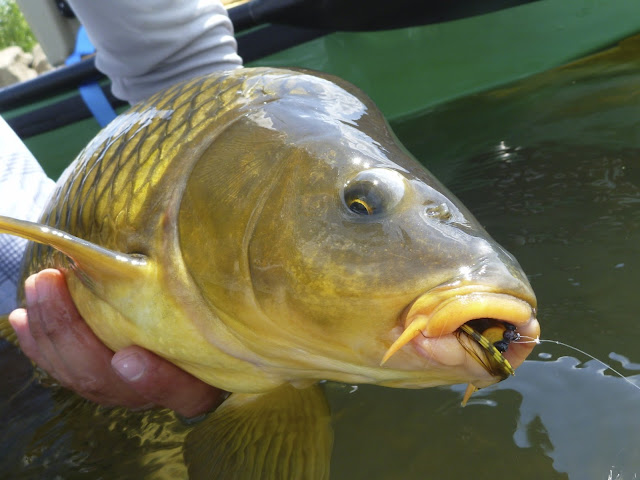When I began targeting common carp in my local rivers and creeks, I wanted to design a versatile pattern to imitate one of their major food items: crayfish. I was looking for it to be an easy tie with a lot of movement that incorporated some of my favorite materials like schlappen and UV chenille. At the time, I was tying a lot of saltwater patterns for bonefish and permit and I really liked a pattern out of the northeast by Dave Skok called the Diablo Crab. It featured schlappen to create the wide flat body of a crab and the use of those feathers creates a lot of subtle movement on the strip or in any type of current. A very popular carp fly at the time was Mctage's Primordial Carp Stew and I used a few techniques on that fly to round out the fly that became known as the "Carp Crab".
The carp crab resembles a crab but is fished and does a great job of mimicking the profile and movement of a crayfish. When sinking or stripped, the schlappen collapses forming the profile of a darting crawdad. When stopped, the schlappen protrudes outwards and the fly performs a slight headstand resembling a crayfish in the defensive position. The fly is deadly fished on my home rivers of the Delaware and Susquehanna for carp. I've watched carp move over ten feet to take the fly and spin 180 degrees to turn around for second look and eat it. It is commercially available from Catch Fly Fishing and a step by step follows.
Two of the most productive colors...
An average Delmarva creek carp...
Upper Delaware river carp...
A yellow carp crab that received a workout on the Susquehanna
Carp Crab Materials List:
Hook: Gamakatsu B10S Sizes 4 & 6
Weight: Lead Dumbbell Eyes
Claws/Antennae: MFC Speckled Sexi Legs
Underbody: UV Polar Chenille
Body: Schlappen
Bottom: Thin Skin
Top: Stripped Rabbit
My favorite hook.
Since I typically fish the carp crab in creeks and rivers, I tie it using a variety of dumbbell sizes and weights. The deeper and faster the current, the heavier the dumbbell eyes should be. The eyes are always on the heavier side so the fly sits on the bottom and is not pushed around by the current.
You can also vary the number of rubber legs on the fly. These resemble the claws and antennae of a crayfish. I typically tie in between 4 and 8 rubber legs spread evenly on either side of the hook shank. They should be flared outwards and tied on the beginning of the bend on the hook.
Tie in a strip of thin skin. It's width should fit between the dumbbell eyes.
When choosing a schlappen feather, find one that has a strong taper to it's width.
An easy mistake people make when trying to replicate this fly happens here. The schlappen feather should be tied in at the base of the stem with the longer feathers wrapped near the bend of the hook.
Tie in UV polar chenille and palmer forward.
Fluff out the chenille and trim.
Palmer forward the schlappen.
The importance of tying in the base of the schlappen feather first is shown here. When wet, the longer feathers on the bend of the hook form the crayfish's claws and create a better profile as shown below...
Clip about an inch of rabbit fur off of a zonker strip. Here I am using the frosty tip rabbit from Orvis. Make sure to pull out any guard hairs from the base of the clump.
Tie in just enough to obscure the hook point. Craft fur or Arctic Fox cab be substituted here.
Trim and bring the thread to the front of the fly.
Rotate the fly to the bottom and splay the schlappen and polar chenille to the sides of the shank.
Bring forward the thin skin and tie off. In his excellent book, The Best Carp Flies: How to Tie and Fish Them, Jay Zimmerman uses scud back here and reinforces it with ribbing to make the fly more durable.
Bottom
Fish POV
Top
Carp love burnt orange
A slight variation...
A hybrid carp crab...
Probably the most epic take I had on a carp crab. I targeted a nice common behind a large log jam. The splash of the fly spooked the fish but another common came out of the log and moved over ten feet to take the carp crab off the bottom. Crazy...
Some older, larger variations.
Meat eater...
Good luck!


















































2 comments:
👌
Those are some awesome looking carp flies! 👍
Thank you for sharing your pictures and tying recipes.
Post a Comment